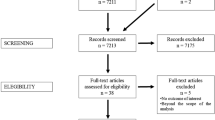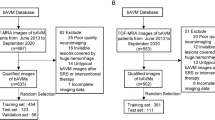Abstract
Purpose
Exact knowledge about the nidus of an arteriovenous malformation (AVM) and the connected vessels is often required for image-based research projects and optimal therapy planning. The aim of this work is to present and evaluate a computer-aided nidus segmentation technique and subsequent angiographic characterization of the connected vessels that can be visualized in 3D.
Methods
The proposed method was developed and evaluated based on 15 datasets of patients with an AVM. Each dataset consists of a high-resolution 3D and a 4D magnetic resonance angiography (MRA) image sequence. After automatic cerebrovascular segmentation from the 3D MRA dataset, a voxel-wise support vector machine classification based on four extracted features is performed to generate a new parameter map. The nidus is represented by positive values in this parameter map and can be extracted using volume growing. Finally, the nidus segmentation is dilated and used for an automatic identification of feeding arteries and draining veins by integrating hemodynamic information from the 4D MRA datasets.
Results
A quantitative comparison of the computer-aided AVM nidus segmentation results to manual gold-standard segmentations by two observers revealed a mean Dice coefficient of 0.835, which is comparable to the inter-observer agreement for which a mean Dice coefficient of 0.830 was determined. The angiographic characterization was visually rated feasible for all patients.
Conclusion
The presented computer-aided method enables a reproducible and fast extraction of the AVM nidus as well as an automatic angiographic characterization of the connected vessels, which can be used to support image-based research projects and therapy planning of AVMs.







Similar content being viewed by others
References
Stapf C, Mast H, Sciacca RR, Berenstein A, Nelson PK, Gobin YP, Pile-Spellman J, Mohr JP (2003) The New York Islands AVM study: design, study progress, and initial results. Stroke 34(5): e29–e33
Fiehler J, Illies T, Piening M, Saring D, Forkert N, Regelsberger J, Grzyska U, Handels H, Byrne JV (2009) Territorial and microvascular perfusion impairment in brain arteriovenous malformations. AJNR Am J Neuroradiol 30(2):356–361
Choi JH, Mohr JP (2005) Brain arteriovenous malformations in adults. Lancet Neurol 4(5):299–308
Anbarasu A, Gould DA (2002) Diagnosis of an intracranial arteriovenous malformation using extracranial carotid Doppler sonography. J Clin Ultrasound 30(4):249–252
Lantz ER, Meyers PM (2008) Neuropsychological effects of brain arteriovenous malformations. Neuropsychol Rev 18(2):167–177
Ogilvy CS, Stieg PE, Awad I, Brown RD Jr, Kondziolka D, Rosenwasser R, Young WL, Hademenos G (2001) Recommendations for the management of intracranial arteriovenous malformations: a statement for healthcare professionals from a special writing group of the Stroke Council, American Stroke Association. Circulation 103(21):2644–2657
Bullitt E, Aylward S, Bernard EJ Jr, Gerig G (2001) Computer-assisted visualization of arteriovenous malformations on the home personal computer. Neurosurgery 48(3):576–582 (discussion 582–573)
Forkert ND, Fiehler J, Illies T, Möller DP, Handels H, Säring D (2012) 4D blood flow visualization fusing 3D and 4D MRA image sequences. J Magn Reson Imaging 36(2):443–453
Nyui Y, Ogawa K, Kunieda E (2000) Extraction of arteriovenous malformation with factor analysis. In: Proceedings of international conference on image processing. vol 622, pp 621–624
Babin D, Pizurica A, Bellens R, De Bock J, Shang Y, Goossens B, Vansteenkiste E, Philips W (2012) Generalized pixel profiling and comparative segmentation with application to arteriovenous malformation segmentation. Med Image Anal 16(5):991–1002
Fink C, Ley S, Kroeker R, Requardt M, Kauczor HU, Bock M (2005) Time-resolved contrast-enhanced three-dimensional magnetic resonance angiography of the chest: combination of parallel imaging with view sharing (TREAT). Invest Radiol 40(1):40–48
Kholmovski EG, Alexander AL, Parker DL (2002) Correction of slab boundary artifact using histogram matching. J Magn Reson Imaging 15(5):610–617
Sled JG, Zijdenbos AP, Evans AC (1998) A nonparametric method for automatic correction of intensity nonuniformity in MRI data. IEEE Trans Med Imaging 17(1):87–97
Forkert ND, Säring D, Fiehler J, Illies T, Möller D, Handels H (2009) Automatic brain segmentation in time-of-flight MRA images. Methods Inf Med 48(5):399–407
Forkert ND, Schmidt-Richberg A, Fiehler J, Illies T, Möller D, Handels H, Säring D (2011) Fuzzy-based vascular structure enhancement in time-of-flight MRA images for improved segmentation. Methods Inf Med 50(1):74–83
Forkert ND, Schmidt-Richberg A, Fiehler J, Illies T, Möller D, Säring D, Handels H, Ehrhardt J (2013) 3D cerebrovascular segmentation combining fuzzy vessel enhancement and level-sets with anisotropic energy weights. Magn Reson Imaging 31(2):262–271
Nyström I, Smedby Ö (2000) New presentation method for magnetic resonance angiography images based on skeletonization. In: SPIE medical imaging: image display and visualization. pp 515–522
Sato Y, Nakajima S, Shiraga N, Atsumi H, Yoshida S, Koller T, Gerig G, Kikinis R (1998) Three-dimensional multi-scale line filter for segmentation and visualization of curvilinear structures in medical images. Med Image Anal 2(2):143–168
Joachims T (1999) Making large-scale support vector machine learning practical. In: Schölkopf B, Burges CJC, Smola AJ (eds) Advances in kernel methods. MIT Press, Cambridge, MA, pp 169–184
Forkert ND, Fiehler J, Ries T, Illies T, Möller D, Handels H, Säring D (2011) Reference-based linear curve fitting for bolus arrival time estimation in 4D MRA and MR perfusion-weighted image sequences. Magn Reson Med 65(1):289–294
Illies T, Forkert ND, Säring D, Wenzel K, Ries T, Regelsberger J, Wegscheider K, Fiehler J (2012) Persistent hemodynamic changes in ruptured brain arteriovenous malformations. Stroke 43(11):2910–2915
Spetzler RF, Martin NA (1986) A proposed grading system for arteriovenous malformations. J Neurosurg 65(4):476–483
Spetzler RF, Hargraves RW, McCormick PW, Zabramski JM, Flom RA, Zimmerman RS (1992) Relationship of perfusion pressure and size to risk of hemorrhage from arteriovenous malformations. J Neurosurg 76(6):918–923
Aoyama H, Shirato H, Katoh N, Kudo K, Asano T, Kuroda S, Ishikawa T, Miyasaka K (2005) Comparison of imaging modalities for the accurate delineation of arteriovenous malformation, with reference to stereotactic radiosurgery. Int J Radiat Oncol Biol Phys 62(4):1232–1238
Sato S, Kodama N, Sasaki T, Matsumoto M, Ishikawa T (2004) Perinidal dilated capillary networks in cerebral arteriovenous malformations. Neurosurgery 54(1):163–168 (discussion 168–170)
Miyasaka Y, Yada K, Ohwada T, Kitahara T, Kurata A, Irikura K (1992) An analysis of the venous drainage system as a factor in hemorrhage from arteriovenous malformations. J Neurosurg 76(2):239–243
Illies T, Forkert ND, Ries T, Regelsberger J, Fiehler J (2013) Classification of cerebral arteriovenous malformations and intranidal flow patterns by color-encoded 4D-hybrid-MRA. AJNR Am J Neuroradiol 34(1):46–53
Conflict of interest
None.
Author information
Authors and Affiliations
Corresponding author
Rights and permissions
About this article
Cite this article
Forkert, N.D., Illies, T., Goebell, E. et al. Computer-aided nidus segmentation and angiographic characterization of arteriovenous malformations. Int J CARS 8, 775–786 (2013). https://doi.org/10.1007/s11548-013-0823-9
Received:
Accepted:
Published:
Issue Date:
DOI: https://doi.org/10.1007/s11548-013-0823-9




